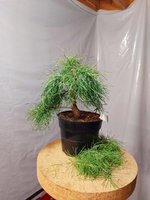Ugo
Shohin
Hi everyone!
I'm in my first year of experience with larch.
This is a small European Larch I got a few months ago.
The question as already be asked but due to lack of experience I prefer learning from actual situations as it helps me to better understand instead of assuming I understand.
I was wondering if this can be qualified as sun burn or possible underwatering...
The top of the tree seems to have more pale / yellow needles since a few days.
Little resume:
The reason why I put aside others causes is because I monitor the water needs of my tree each days using toothpicks almost completely planted in substrate.
I had an hesitation on watering the tree 4 days ago as I try to be careful to not overwater.. let say 3/4 of an inch of substrate was dry while the rest of the pot was still humid, semi cloudy day.
I totally underestimated the sun and wind later in the morning and afternoon.
The tree is in a standard 6in black nursery pot and didn't need repotting this year and its sitting on a dark brown bench... I will correct this situation as I'm afraid the roots get cooked during Summer.
When I first got this tree I added coarse sphagnum moss on top of the substrate but that's not touching the trunk thinking it would help to keep up moisture level of the surface roots during heat spells.
When I brought it home it was babied inside a growing tent, the tent was the easiest way to reproduce the conditions in which I bought the tree at the beginning of February.
Let say it had an early start this year!
I brought it outside where the tree is under full sun all day long in zone 5B about 4 weeks ago but this week forecast the first major heat spell we have since the beginning of Spring including the past 4 days.
I would like to know if the tree should be taking out from afternoon sun until I confirm the issue if this is even an issue!?
Can you help me confirm the problem if there's one?!

Thank you and sorry to ask a question that may be obvious for more experienced members!
Ugo
I'm in my first year of experience with larch.
This is a small European Larch I got a few months ago.
The question as already be asked but due to lack of experience I prefer learning from actual situations as it helps me to better understand instead of assuming I understand.
I was wondering if this can be qualified as sun burn or possible underwatering...
The top of the tree seems to have more pale / yellow needles since a few days.
Little resume:
The reason why I put aside others causes is because I monitor the water needs of my tree each days using toothpicks almost completely planted in substrate.
I had an hesitation on watering the tree 4 days ago as I try to be careful to not overwater.. let say 3/4 of an inch of substrate was dry while the rest of the pot was still humid, semi cloudy day.
I totally underestimated the sun and wind later in the morning and afternoon.
The tree is in a standard 6in black nursery pot and didn't need repotting this year and its sitting on a dark brown bench... I will correct this situation as I'm afraid the roots get cooked during Summer.
When I first got this tree I added coarse sphagnum moss on top of the substrate but that's not touching the trunk thinking it would help to keep up moisture level of the surface roots during heat spells.
When I brought it home it was babied inside a growing tent, the tent was the easiest way to reproduce the conditions in which I bought the tree at the beginning of February.
Let say it had an early start this year!
I brought it outside where the tree is under full sun all day long in zone 5B about 4 weeks ago but this week forecast the first major heat spell we have since the beginning of Spring including the past 4 days.
I would like to know if the tree should be taking out from afternoon sun until I confirm the issue if this is even an issue!?
Can you help me confirm the problem if there's one?!

Thank you and sorry to ask a question that may be obvious for more experienced members!
Ugo


